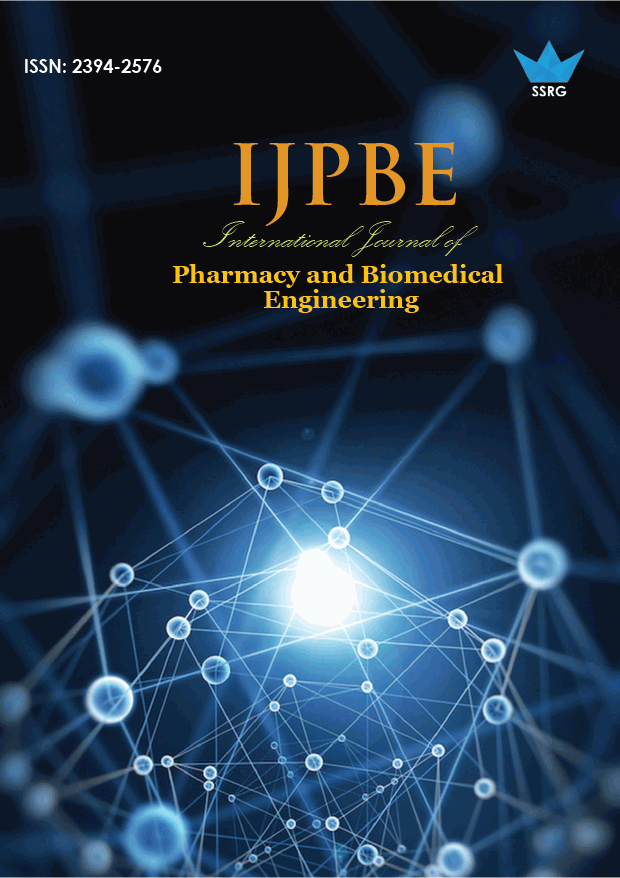Preparation and Evaluation of Microparticles Containing Charantin by Solvent Evaporation Technique

| International Journal of Pharmacy and Biomedical Engineering |
| © 2019 by SSRG - IJPBE Journal |
| Volume 6 Issue 1 |
| Year of Publication : 2019 |
| Authors : Nirupama K V, Adlin Jino Nesalin J, Tamizh Mani T |
How to Cite?
Nirupama K V, Adlin Jino Nesalin J, Tamizh Mani T, "Preparation and Evaluation of Microparticles Containing Charantin by Solvent Evaporation Technique," SSRG International Journal of Pharmacy and Biomedical Engineering, vol. 6, no. 1, pp. 24-28, 2019. Crossref, https://doi.org/10.14445/23942576/IJPBE-V6I1P103
Abstract:
The Charantin loaded microparticles were prepared by the solvent evaporation technique by using Eudragit S 100 polymer. Microparticles of different core: coat ratio were formulated and evaluated for process yield, loading efficiency, particle size, zeta potential, in vitro drug release kinetic studies, and stability studies. The microparticles were prepared to have a particle diameter ranging approximately 68-81µm and a zeta potential 85 to 101mV. There was a steady increase in the entrapment efficiency of increasing the polymer concentration in the formulations. The in vitro release for all drug-loaded batches were found to follow to first order and provided sustained release throughout 24 h. No appreciable difference was observed in the drug content of product during 90 days in which microparticles were stored at 4˚C, room temperature, and some little difference found in drug content of product during 90days in which microparticles were stored at an accelerated temperature of 40℃ ± 2℃/75% RH. According to the data obtained, these microparticles containing Charantin opens new and exciting perspectives as drug carriers for treating the Diabetes mellitus.
Keywords:
Microparticles, Eudragit S 100, Charantin, solvent evaporation method.
References:
[1] Parasuraman S, Thing GS, Dhanaraj SA. Polyherbal formulation-concept of Ayurveda. cog Rev. 2014;8(16):73- 80.
[2] Mishra R, Shuaib M, Shravan, Mishra PS. A review of herbal antidiabetic drugs. J Appl Pharm Sci. 2011;1(6):235-37.
[3] Chowdary KPR, Ravi Shankar K, Subrahmanyam SVV. “Preparation and evaluation of pregelatinized starch microspheres”. World J Pharm Res. 2014;3(10):467-74.
[4] Desai S, Pratima T. Charantin: An important lead compound from Momordica charantia for the treatment of diabetes. J Phcog & Phytochem. 2015;3(6):163-66.
[5] Deshmukh CD, Jain A. Diabetes mellitus: A review. Int J Pure App Biosci. 2015;3(3):224-30.
[6] Munmun K, Kshitiz KB, Vijay S, Sharanagat b, Ashish D. “Green synthesis and characterization of silver nanoparticles using Momordica Charantia and Manilkara zapota seeds”. Eco Env & Cons. 2015;21:251-57.
[7] Subhash Chandra P, Tushar P, Kaushal P, Yagnesh B, Yogesh P, Dr. N.M. Patel B. “Isolation, characterization, and antimicrobial activity of charantin from Momordica charantia Linn. Fruit”. Int J Drug Dev. & Res. 2010;2(3):629-34
[8] Somya G, Nayyar P, Akanksha B, Pramod K, Sharma. “Microspheres based on herbal actives: the less-explored ways of disease treatment”. Egypt Pharm J. 2015;14:148–57.
[9] Jing-Yi Hou, Li-Na Gao, Fan-Yun Meng, Yuan-Lu Cui. Mucoadhesive Microparticles for Gastro retentive Delivery: “Preparation, Biodistribution, and Targeting Evaluation”. Mar Drugs. 2014;12:5764-87
[10] Krithiga J, Briget Mary M. “Synthesis of Agnps of Momordica charantia Leaf Extract, Characterization and Antimicrobial Activity”. Pharm Anal Acta. 2015;6(10):1-7.
[11] Sivasankar MG, Krishna M, Sunitha RM. “Formulation, evaluation, and optimization of sustained-release microcapsules of lornoxicam prepared with gum dikamali & pectin extracted from dillenia indica”. Int J Chem Sci. 2015;13(1): 97-106.
[12] Malay Kumar Das and Kalakuntala Rama Rao. “Evaluation of Zidovudine encapsulated ethylcellulose microspheres prepared by water-in-oil-in-oil (W/O/O) double emulsion solvent diffusion technique.” Acta Poloniae Pharm Drug Res. 2006. 63: 141-148.
[13] Naveen HP, Adlin Jino Nesalin J, Tamizh Mani T. “Preparation and characterization of microsphere encapsulating Ritonavir by solvent evaporation technique.” Imperical journal of interdisciplinary research.2016;2(2):64- 72
[14] Adlin Jino Nesalin J, Anton SA. “Preparation and evaluation of chitosan nanoparticles containing zidovudine”. Asian Journal of Pharmaceutical Sciences 2012;7(1):80-84.
[15] Durgacharan AB, Mangesh AB, Sachin ST, Shrinivas KM, Yogesh SG. “Formulation and evaluation of Controlled Release Microspheres of Isosorbide dinitrate”. Int.J. PharmTech Res.2009;1(2):125-128.
[16] Praveen Kumar Gaur, Shikha Mishra, Meenakshi Bajpai. “Formulation and evaluation of controlled-release of telmisartan microspheres: In vitro/in vivo study”. Journal of food and drug analysis.2014;22:542-548.
[17] Burcu devrim, Kandemir canefe. “Preparation and evaluation of modified release ibuprofen microspheres with acrylic polymers (eudragitr) by quasiemulsion solvent diffusion method: effect of variables”. Acta Poloniae Pharmaceutica-Drug Research. 2006;63(6):521-534.
[18] Chitra Singh Purohit S, Pandey BL, Madhu Singh. “Solvent Evaporation Technique of Microencapsulation: A Systemic Review”. International Journal of Advances in Pharmaceutical Analysis (IJAPA).2014;4(3):96-104.
[19] Abhishek, SB, Parthiban S, Senthil Kumar G P, Tamizh Mani T. “Formulation of Eudragit S-100 coated sodium alginate microspheres of Azathioprine for colon targeting.” World Journal of Pharmacy and Pharmaceutical Sciences.2018;7(5):1612-1627.
[20] Hussain Mohammed Asif, Renukuntla Arun Kumar, Rama Rao T, Maimuna Anjum. “Preparation and evaluation of ethylcellulose microspheres prepared by the solvent evaporation technique.” Int J Pharm Sci, 2014;6(7):264-266.

 10.14445/23942576/IJPBE-V6I1P103
10.14445/23942576/IJPBE-V6I1P103